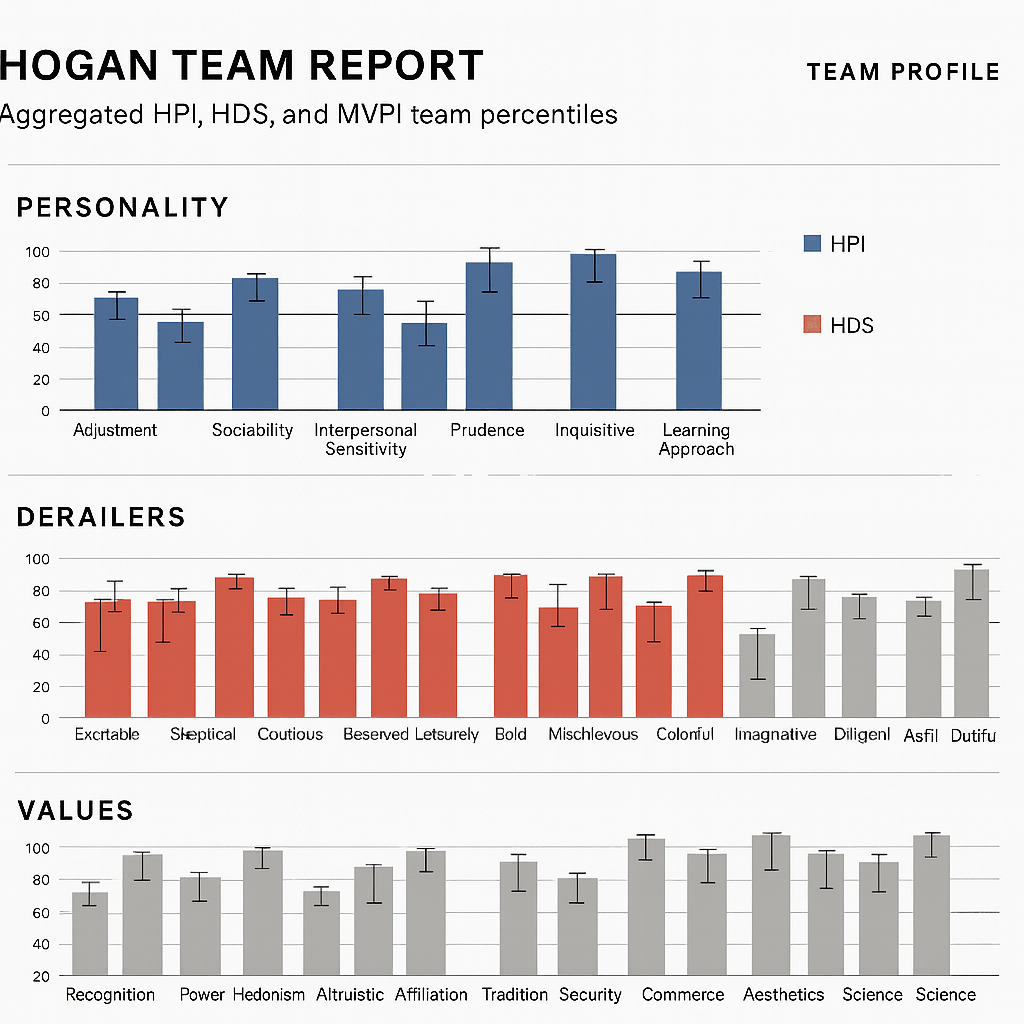Hogan Team Coaching: Turning Insight into Collective Performance
Executive Summary
In complex transformations, leadership performance depends less on individual brilliance and more on collective behaviour. Hogan team coaching combines data-driven personality insights with systemic group dynamics coaching to help executive teams recognise and reshape the patterns that limit performance.
In this article, you’ll learn how Hogan’s three core assessments - HPI, HDS and MVPI - can be applied at the team level, what a typical process looks like, and how this approach creates measurable behavioural change in, for example, transformation and innovation leadership teams.
Why Team Coaching, Not Just Individual Coaching?
Even capable leaders can struggle when collective dynamics are left unchecked. Misunderstandings multiply, trust erodes, and energy drains into recurring loops - the same meetings, the same frustrations, the same unspoken tensions.
Individual coaching builds self-awareness; team coaching builds shared awareness - how personalities, motives, and stress responses interact across the system. Once these patterns are visible, the team can consciously reset how it operates.
The Hogan Framework: Three Lenses on Behaviour
Hogan’s three scientifically validated assessments each reveal a different dimension of behaviour:
HPI (Hogan Personality Inventory®) – how people show up on a good day; their reputation and natural style.
HDS (Hogan Development Survey®) – how behaviour changes under stress; the derailers that disrupt teamwork.
MVPI (Motives, Values, Preferences Inventory®) – what drives people; the values and culture that shape decisions.
In team coaching, we aggregate these results not to average people but to illuminate shared patterns, areas of tension, and relational complementarities - a mirror for how the team behaves as a system.
(Hogan’s facilitator guide recommends using aggregation as a developmental lens, not a ranking tool.)
Hogan team report dashboard showing aggregated HPI, HDS and MVPI data
A Fictional Case (due to confidentiality): The Transformation Steering Group
Team composition: Six senior leaders - COO, CHRO, VP Transformation, VP Technology, Head of PMO, Head of Culture.
Mandate: Lead a global transformation programme.
Aggregated Hogan patterns reveal:
High Ambition and Prudence: driven, structured, but prone to slow decisions.
High Cautious and Sceptical: strong governance but defensive under scrutiny.
Mixed Values: half focused on Security, half on Innovation - cultural friction between safety and creativity.
Note: these aggregated patterns reflect distributions (how many team members lean in these directions) rather than absolute “team averages.” For example, a few high Cautious scores can exert influence beyond majority trends. Hogan calls this a Domino Derailer effect, where one person’s stress behaviour cascades into group dynamics under pressure.
Interpretation: An intellectually strong but emotionally risk-averse team. Their collective challenge becomes shifting from debate and caution to decisive, aligned action under ambiguity.
The Hogan Team Coaching Process
A structured approach converts diagnostic insight into behavioural change. One proven model includes five stages:
1. Preparation and Context
Clarify objectives and desired outcomes with the team sponsor. Conduct confidential individual Hogan debriefs (90 minutes each) to ensure each member understands their data and feels ready to share insights. Participants must process their personal data in private before collective discussion. This helps maintain psychological safety in the team workshop.
2. Sense-Making Workshop
Bring the team together to review the aggregated results. Encourage curiosity rather than judgement. Ask:
“What do we notice about ourselves as a system?”
“Where do these patterns show up day to day?”
3. Exploring Group Dynamics
Here the coach introduces systemic observation. Typical questions include:
Who tends to dominate or withdraw?
What emotional triggers repeat across the team?
How does pressure change our interactions?
For instance, when a Bold leader pushes for quick decisions, Cautious colleagues retreat, while Dutiful members smooth over conflict - creating a Domino Derailer™ loop that slows execution.
4. Designing Behavioural Experiments
The team chooses a few experiments for the next quarter, such as:
Rotating meeting facilitation to balance voices
Setting a fixed ratio between discussion and decision time
Practising short “pause and check” moments when tension rises
Each experiment links directly to a Hogan insight, reinforcing awareness through action.
5. Embedding and Review
After 8–12 weeks, the team revisits progress. Shifts might include improved decision speed, more balanced participation, or stronger psychological safety. The aim is sustained change, not a one-off workshop.
Revisiting progress is ideally done via pulse diagnostics and optional re-mapping of Hogan data after 9–12 months, to see whether collective patterns have shifted.
Integrating Group Dynamics Coaching
Hogan data provides structure and objectivity, while group dynamics coaching brings the emotional and relational insight. A skilled coach helps the team:
Notice live dynamics during sessions
Surface unspoken assumptions and tensions
Work through emotional responses to data
Experiment with new relational patterns
When used together, Hogan diagnostics create the what (insight), and group dynamics coaching enables the how (change).
In practice, the coach monitors live relational moves - resistance, alliances, disengagement - and links them back to the Hogan lens. This interplay between data and in-the-moment observation is what makes the methodology robust.
Typical Workshop Flow
Morning:
Set purpose and psychological contract
Creta psychological safety
Review team map and aggregated patterns
Discuss strengths and risks in relation to transformation goals
Afternoon:
Identify and map Domino Derailers
Co-create new operating norms
Define 2–3 collective experiments
Close with reflection: “What do we now understand about our team that we didn’t before?”
Outputs include a concise Team Behavioural Charter, shared language for derailers, and clear behavioural commitments.
Measuring Progress
Success is best measured through both qualitative and quantitative data:
Pulse surveys on trust, cohesion and psychological safety
Observation of meeting quality and participation balance
Stakeholder feedback on decision-making and delivery pace
Optional re-assessment of Hogan data after 12 months
Importantly, when re-mapping Hogan, treat observed changes as directional - look for shifts in risk thresholds rather than radical changes in percentile ranks.
The result is a credible story of behaviour change backed by data.
Common Pitfalls
Focusing on individuals rather than patterns. Hogan is meant to highlight systemic dynamics; avoid making it about ‘who is good’ or ‘who is bad.
Insufficient contracting. Ensure confidentiality and purpose are clear from the outset.
Data without dialogue. Insight only creates value when discussed openly.
No follow-through. Behavioural experiments require tracking and reflection.
Misusing aggregated data for selection or promotion decisions. Hogan’s Team Report is strictly for developmental purposes, not HR evaluation or rankings.
Conclusion
Hogan team coaching brings the precision of personality science into the messy reality of team behaviour. When combined with skilled group dynamics coaching, it enables executive teams to recognise their patterns, challenge unhelpful habits, and practise new ways of working together.
For transformation leaders, this is more than leadership development - it’s the foundation for sustainable cultural change.
Want to explore your team’s deeper patterns through Hogan’s official team methodology - in a way that safeguards trust, promotes system insight, and accelerates performance? Let’s have a conversation about designing a bespoke, development-centered programme.
Book a 30-minute consultation →
Internal Links
Thriving in Matrix Organisations → for distributed and cross-functional dynamics
The ROI of Executive Coaching → for linking diagnostics to measurable outcomes
Team Psychology Experiments → for behavioural experiment design
Structured FAQ
Q. What is Hogan team coaching?
It’s the application of Hogan’s three personality assessments (HPI, HDS and MVPI) at the team level to identify shared strengths, risks, and values, and to coach the team as a system.
Q. Is aggregated Hogan data valid or safe to share with a team?
Yes - when used thoughtfully under the right conditions. Hogan’s methodology emphasises that aggregated data should be used for development, not comparison. Before any team workshop, individual debriefs and confidentiality norms ensure participants feel psychologically safe sharing to collective insight.
Q. Is Hogan team coaching a separate tool?
No. It uses existing Hogan instruments, aggregated and interpreted for the group.
Q. How long does a Hogan team coaching process take?
Typically three to four months, including individual debriefs, a team workshop, and a follow-up review.
Q. What are Domino Derailers?
Patterns where one person’s stress behaviour triggers another’s, creating repeating loops that disrupt team performance.
Q. Can Hogan team coaching be combined with other approaches?
Yes. It’s highly effective when integrated with group dynamics coaching, systemic team coaching, or transformation leadership programmes.
Hogan Personality Inventory, Hogan Development Survey, and Motives, Values, Preferences Inventory are registered trademarks of Hogan Assessment Systems, Inc.
👉 Curious how these insights apply to you or your own leadership team?
Let’s explore where coaching could create measurable impact for your organisation.
📞 Book a 30-minute consultation
Take a look at our 1:1 Coaching or Team Development Coaching approaches
Alternatively….
📖 Need some clarity? Read the FAQ
📚 My Book Reading list on the themes of change
🎥 Watch the Change Video listings
Hogan Personality Inventory®, Hogan Development Survey®, Motives, Values, Preferences Inventory®, and Hogan Team Report® are registered trademarks, and Domino Derailer™ is a trademark of Hogan Assessment Systems, Inc. This article is an independent discussion of evidence-based team coaching practices and is not endorsed by or affiliated with Hogan Assessment Systems.














